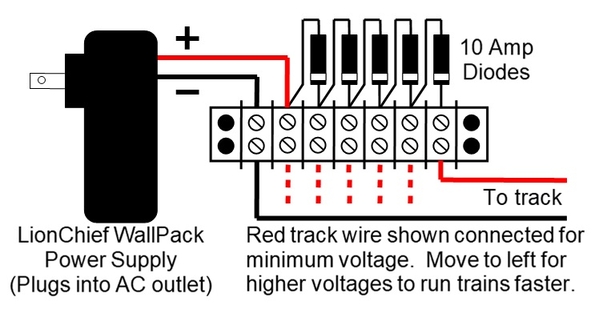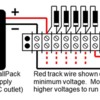When I built a "Children's Layout" for the San Luis Obispo Railroad Museum (in California) and later a similar and larger layout for the Exploration Discovery Center in Grover Beach, CA, it was clear I needed to limit LionChief top speeds.
When I tested some engines using a LionChief 36 watt WallPack with a Santa Fe FT diesel and a Southern Pacific 0-8-0 steam engine, the top speed could best be described as "ludicrous speed". The diesel got a little above 100 scale MPH. Surprisingly, it hung on to O36 curves.
Just to put the voltages and currents into perspective, the 36 watt WallPack is nominally about 18 VDC with a 2 amp maximum. I found that this was sufficient to operate two trains, even with one having lighted passenger cars (three had LEDs and one was incandescent). If more current were needed, a 72 watt WallPack could be used, but then when a short occurred, such as from a derailment, there would be 4 amps through the short instead of only 2 amps. Incidentally, these WallPack supplies have "fold back current limiting" which means that they will not deliver more than 2 amps. The power supply electronics automatically lowers the voltage as needed to limit the current. Remove the short, and voila, the voltage returns to normal. MUCH more convenient than a circuit breaker.
And for current draw reference, I found that with no load the voltage was 19 VDC. The voltage was 17.5 VDC and current 0.775 amps when running both trains at moderate speed. Either engine pulled about 1.5 amps if stalled at full throttle. So, things were easily within the 36 watt WallPack capability and voltage remained pretty near 18 VDC.
I did some testing with a variable power supply and determined that lowering the track voltage a little greatly helped limit top speed to something less frightening. Of course, you can't go too low with the voltage, or the electronics will stop working and you won't get any motion.
Lowering the DC voltage from the Wall Pack could be done very cheaply and easily just using diode drops. One silicon diode drops about 0.6 VDC. You can put more than one in series to drop more voltage as the voltage drops simply add up. All current passes through each diode so you need a type with a high enough rating. I used 10 amp diodes which was more than enough safety margin. They cost very little and if you search for "10 amp diode" on Amazon you will see many choices where you get maybe 20 of them for about $6. (Of course, they are available from DigiKey, Mouser, eBay, and others.)
I did some testing of the two engines and found that they behaved very differently at different track voltages. The chart below shows the difference (In terms of diode voltage drops). This suggested that five diode drops would be about the maximum that could be used.
This is a diagram of the diode drop scheme. By simply moving the red "To track" wire to different positions on the terminal block you can get everything from full voltage to a total of 5 diode drops (about a 3 volt drop). I thought it best to allow choices in the degree of voltage reduction.
The photo below is the actual implementation. A piece of terminal track was cut and used as a means to interface the WallPack plug to the terminal block. You could certainly just cut the WallPack plug off and directly connect its wires to the terminal block. But I wanted people at the museum to be able to easily replace the WallPack without having to do any wiring work. So, they can take another WallPack out of the box and swap it out quickly. (As of this writing, in over three years of operation, the WallPack has never failed. And there have been a LOT of derailment short circuits.) Also, the two positions at the right end of the terminal block are for a different purpose which is a fixed 4.5 VDC power supply used to power LionChief controllers that are surface mounted to the layout which nicely eliminates the need to ever change batteries.
NOTE: I had also considering putting diode drops INSIDE each locomotive in series with one of the wires providing power to the motor(s). This would require two sets of diodes in parallel in opposite directions. That would allow "fine tuning" each engine and being able to "speed match" top speeds fairly well. But I decided it wasn't practical for future maintenance and engine replacement in a museum environment. That it was best to leave the engines unmolested.








